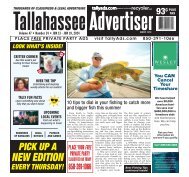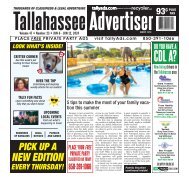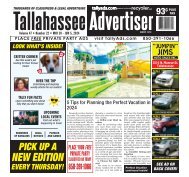Create successful ePaper yourself
Turn your PDF publications into a flip-book with our unique Google optimized e-Paper software.
thetrucker.com<br />
Business <strong>December</strong> <strong>15</strong>-<strong>31</strong>, 20<strong>15</strong> • 29<br />
Minimizer continues growth, adds 4<br />
territories to distribution network<br />
THE TRUCKER NEWS SERVICES<br />
BLOOMING PRAIRIE, Minn. — Minimizer,<br />
a provider of heavy truck products, continues<br />
to grow more than three decades after its<br />
inception.<br />
Since the beginning of 20<strong>15</strong>, the company<br />
has added four new territories to its distribution<br />
map, bringing the total number to 16.<br />
“We train our distributors to sell Minimizer<br />
products, but we’ve got so many distributors<br />
now that we need more territory managers to<br />
make it manageable. So we broke up our map<br />
into smaller territories,” Minimizer CEO Craig<br />
Kruckeberg said. “We’ve also brought on board<br />
two regional managers. It’s exciting, because<br />
our team is growing all the time.”<br />
Minimizer started in 1984 with Dick Kruckeberg<br />
selling the company’s now well-known<br />
poly fender out of the back of his truck.<br />
Today, the Minnesota-based business offers<br />
numerous heavy truck products, and is once<br />
again on pace to break its own sales records.<br />
“We’re proud to be an American familyowned<br />
company for more than three decades,<br />
but we’re even more proud to hire American<br />
workers, which are the backbone of our country,”<br />
Kruckeberg said.<br />
Minimizer provides aftermarket solutions<br />
for truck parts, including poly truck fenders,<br />
toolboxes, custom floor mats, mud flaps, truck<br />
maintenance products and other truck accessories.<br />
Kruckeberg said Minimizer uses durable<br />
materials and robotic production technology to<br />
create an industry standard that allows them to<br />
offer the longest guarantee in the industry.<br />
For more information visit Minimizer.com<br />
or e-mail info@minimizer.com.<br />
FMCSA allowing German driver<br />
on U.S. roads for Daimler testing<br />
WASHINGTON — Concluding that the<br />
process for obtaining a German CDL is “comparable<br />
to or as effective as the U.S. CDL requirements,”<br />
the Department of Transportation<br />
<strong>December</strong> 4 granted a German truck driver permission<br />
to drive on U.S. roads without a stateissued<br />
U.S. CDL.<br />
Michael Seitter, a German citizen who<br />
holds a German CDL, will be able to operate<br />
commercial motor vehicles for Daimler Trucks<br />
North America. Seitter, who must be accompanied<br />
by a U.S. CDL holder familiar with the<br />
routes driven, will “support Daimler field tests<br />
to meet future vehicle safety and environmental<br />
requirements and to promote the development<br />
of technology and advancements in vehicle<br />
safety systems and emissions reductions,” according<br />
to a Federal Register notice published<br />
by DOT’s Federal Motor Carrier Safety Administration.<br />
Seitter is the sixth German CDL<br />
holder to be granted a waiver to test drive for<br />
Daimler since 2012.<br />
Daimler told the FMCSA in its petition that<br />
Seitter will “typically” drive only about six<br />
hours per day for two consecutive days and no<br />
more than 200 miles per day “for a total of 400<br />
miles during a two-day period on a quarterly<br />
Business Briefs<br />
basis.” Daimler plans call for 90 percent of the<br />
tests to be driven on interstate highways, with<br />
the rest occurring on two-lane state highways.<br />
Seitter is not eligible to obtain a state-issued<br />
U.S. CDL because only residents of a state can<br />
apply for the license, the notice stated. Daimler<br />
included documentation showing that Seitter<br />
possesses a safe German driving record.<br />
When driving, Seitter must be in possession<br />
of his German CDL and the federal exemption<br />
document, the Federal Register notice stated.<br />
<strong>The</strong> exemption is valid for two years.<br />
NASTC recognizes Wisconsin’s Kretz<br />
Truck Brokerage as broker of the year<br />
NASHVILLE, Tenn. —<strong>The</strong> National<br />
Association of Small Trucking Companies<br />
(NASTC) named Kretz Truck Brokerage of<br />
Antigo, Wisconsin, broker of the year October<br />
29. <strong>The</strong> designation, called the NASTC Best of<br />
the Best Brokers Award, was presented here at<br />
NASTC’s 25th annual conference, said Buster<br />
Anderson, executive vice president of the organization.<br />
“As a recipient of this prestigious award,<br />
Kretz Truck Brokerage has distinguished themselves<br />
as the best of our broker group that includes<br />
over 250 of the best brokers in the country,”<br />
Anderson said. Kretz has been in business<br />
since 1989 and moves in excess of 200<br />
loads per week all over the country, he added.<br />
<strong>The</strong>y have been a NASTC member for over 14<br />
years and have always been a big supporter of<br />
NASTC’s efforts to improve broker-carrier relations,<br />
Anderson said.<br />
NASTC represents more than 6,000 trucking<br />
companies in the U.S. and Canada that<br />
employ over 75,000 drivers collectively. For<br />
the benefit of their trucking company members<br />
NASTC publishes a “Best Brokers” directory<br />
annually to assist their members in locating<br />
quality freight brokers to help them keep their<br />
trucks loaded, the organization said.<br />
FTR Shippers Conditions Index near<br />
neutral for September at -0.5 reading<br />
BLOOMINGTON, Ind. — Transportation<br />
analyst firm FTR’s Shippers Conditions Index<br />
for September registered a near neutral reading<br />
of -0.5, reflecting benign conditions for shippers,<br />
the company stated November 24.<br />
<strong>The</strong> index is expected to start a steady downward<br />
trajectory during the fourth quarter of 20<strong>15</strong><br />
and through 2016, reflecting the current expectations<br />
for freight haulers to institute increased<br />
pricing toward the end of next year, said Jonathan<br />
Starks, director of transportation analysis at<br />
FTR, adding that a portion of the index is based<br />
on forward-looking expectations, so it will rise<br />
or fall based on future probabilities.<br />
See Briefs on p30 m

















